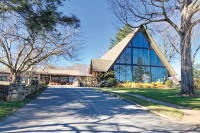We’ll weather the weather, whatever it is
One of my daughter Izzy’s favorite videos is “Little Bear’s Winter Tales.” She likes the episode with the blizzard. The mantra for the characters becomes, “Whether the weather is hot or whether the weather is cold, we’ll weather the weather whatever the weather, whether we like it or not.” It seems like an appropriate mantra for Western North Carolina.
The local axiom is “If you don’t like the weather in the mountains just wait 20 minutes, it’ll change.”
Last Friday (Feb. 3) I was working outside in short sleeves in 60-degree temperatures. By Saturday afternoon it was snowing.
The topography and geography of WNC help create complex localized climates. A report published by the State Climate Office of North Carolina, which analyzed 50 years of data from 1949 to 1998, points out some of these vagaries. According to the report, Asheville’s downtown weather station is one of the driest sites in the state. The 30-year normal annual precipitation for downtown Asheville (from 1961 – 1990) was 37.97 inches. Meanwhile, just down the road, Transylvania County is considered a temperate rain forest, and the normal precipitation measured at Coweeta Hydrological Laboratory for the same time period was 93.2 inches.
According to the study, geography and topography are the reasons for this phenomenon.
“Asheville is one of the driest locations in North Carolina,” the State Climate Office report states. “While the southern mountains of North Carolina generally receive more precipitation than any other region in North Carolina, Asheville is located in the French Broad River valley and is north of a high ridge of mountains. These mountains block the prevailing wind from the southwest and provide a rain shadow effect for the Asheville area. Unlike the rest of the mountains, winds in Asheville are generally from the north along the French Broad River.”
Related Items
The report states that winter precipitation in North Carolina is generally associated with fronts and/or coastal storms. The most common winter weather events are those storms that develop in the Gulf of Mexico and track northeast up the eastern seaboard. It gets real dicey when these storms are in association or conjunction with Alberta Clippers. These clippers bring cold air down from Canada, and when, where and if they collide with that moist Gulf air, they can produce anything from rain to snow and everything in between. Occasionally storms and/or fronts take a different track, diving down from the northeast. These Nor’easters or Hatteras Lows can also wreak wintertime havoc. The mountains and the coast of North Carolina receive the most wintertime precipitation.
The report concluded that most weather trends in North Carolina were local in nature but did note some statewide patterns. “Precipitation in North Carolina has increased over the past 50 years during the fall and winter seasons,” the report states, “but decreased during the summer. Temperatures during the last 10 years are warmer than average but are not warmer than those experienced during the 1950’s. The warm season has become longer as measured by the dates of the last spring freeze and first fall freeze. Generally, the last 10 years were the wettest of the study period.”
Another interesting study I ran across was conducted in the Great Smoky Mountains National Park and surrounding areas by the National Weather Forecast Office in Morristown, Tenn. It dealt with elevation differences and local topography. The study showed that the high temperatures at Newfound Gap with an elevation of approximately 5,000 feet were between 10 and 13 degrees lower than at the Park headquarters, which is at about 1,600 feet. The differences between the low temperatures were only between three and six degrees. This was due to the frequent temperature inversions where the heavy, cold air settles at lower elevations.
One interesting observation compared the temperatures at Park headquarters with the temperatures at McGhee Tyson Airport in Knoxville, Tenn. According to the report, “The largest average temperature differences between the McGhee Tyson Airport and Park Headquarters were observed during the summer with the smallest temperature differences observed during the winter. This was likely the result of increased shade and transpiration during the growing season from the surrounding trees at Park Headquarters compared to the airport.”
The biggest difference was between the minimum summer temperatures with the airport averaging one to five degrees warmer. Isn’t it amazing what a little vegetation can mean?









